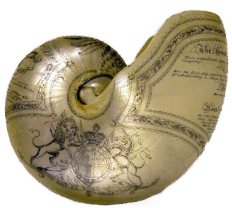Fieldwork and conservation undertaken for the 'Mammoth Graveyard' found in a gravel pit near Swindon. By Nigel Larkin, Dec 2021.
Note, all photographs are copyright Nigel Larkin and Neville Hollingworth
This archaeological site was discovered by Sally and Neville Hollingworth, expert fossil hunters of some renown from Swindon.
It contains the remains of up to five Steppe Mammoths as well as other bones and some Neanderthal handaxes that seem to be associated with the mammoth carcasses.
The site is particularly important because it appears to date to between 210,000 and 220,000 years ago, a time period from which very little is known.
It became quite a famous archaeological site when it was aired on TV in the UK as 'Attenborough and The Mammoth Graveyard' on BBC1 on December 30th 2021.
The site was assessed and excavated by 'Dig Ventures' (a social enterprise organising crowdfunded archaeological excavation experiences), assisted by experts
in archaeology and palaeontology from around the country. My roles in the project included:
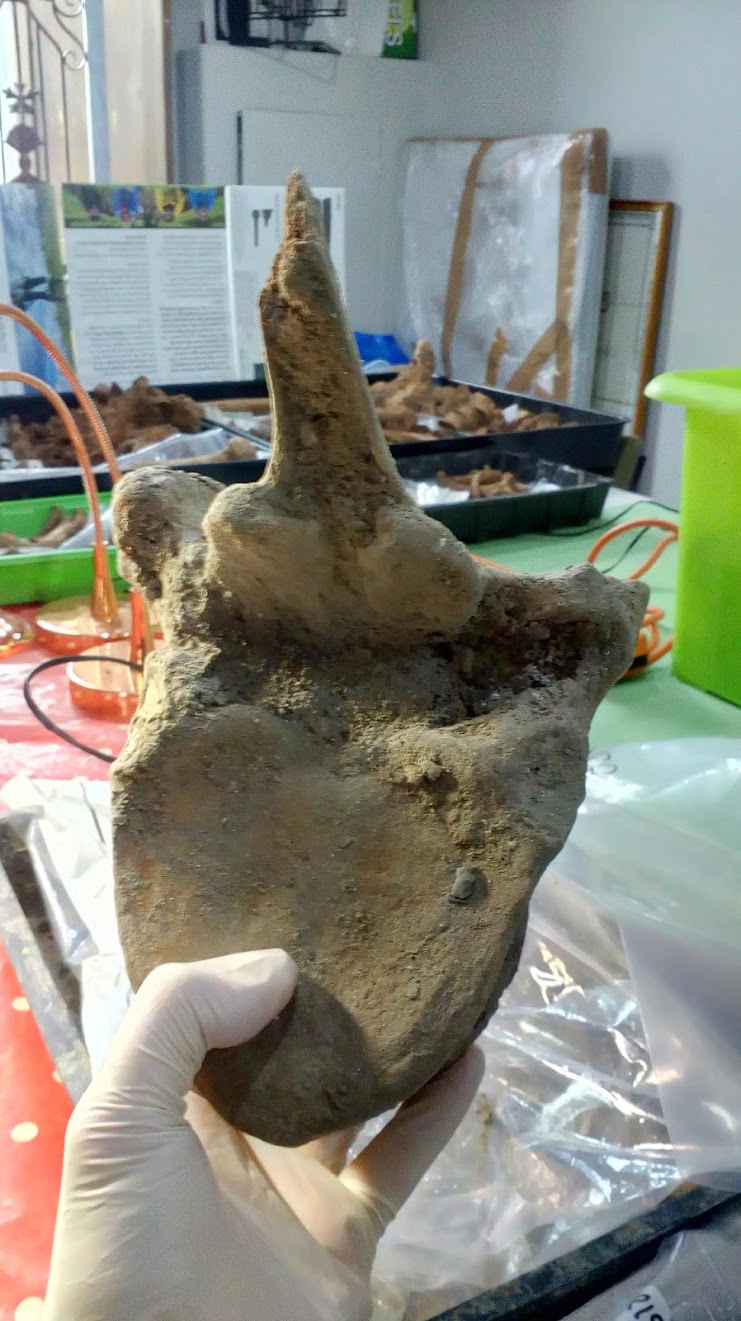 - In advance of the main excavation I was asked to provide the method statement advising how all the bones should
be excavated and handled; I also advised on how the bones etc should be stored (in terms of the environmental conditions
they would need, as well as the storage media)
- In advance of the main excavation I was asked to provide the method statement advising how all the bones should
be excavated and handled; I also advised on how the bones etc should be stored (in terms of the environmental conditions
they would need, as well as the storage media)- I cleaned and conserved all the faunal remains excavated in the first season of digging and wrote their conservation reports
- I excavated, jacketed and lifted the 1.5 m long mammoth tusk
- After the first field season I de-jacketed, cleaned and conserved the mammoth tusk in controlled conditions in my conservation studio.
Image to the right: one of the mammoth vertbrae, before I started cleaning it.
I excavated and lifted this fragile tusk in June 2019. As usual for such tusks found in the UK it is preserved as a several thousand fragments of mammoth ivory preserved in the shape of a tusk, held in place by the surrounding compacted gravels and other sediment. The central portion was damaged by earlier fieldwork. The tusk could only be preserved and collected by using consolidation and making a rigid field jacket, described below. However, because of the careful way this was excavated and later cleaned we can see that the specimen still preserves a good three-dimensional shape with curves that demonstrate it is a left tusk although the very distal tip is missing.

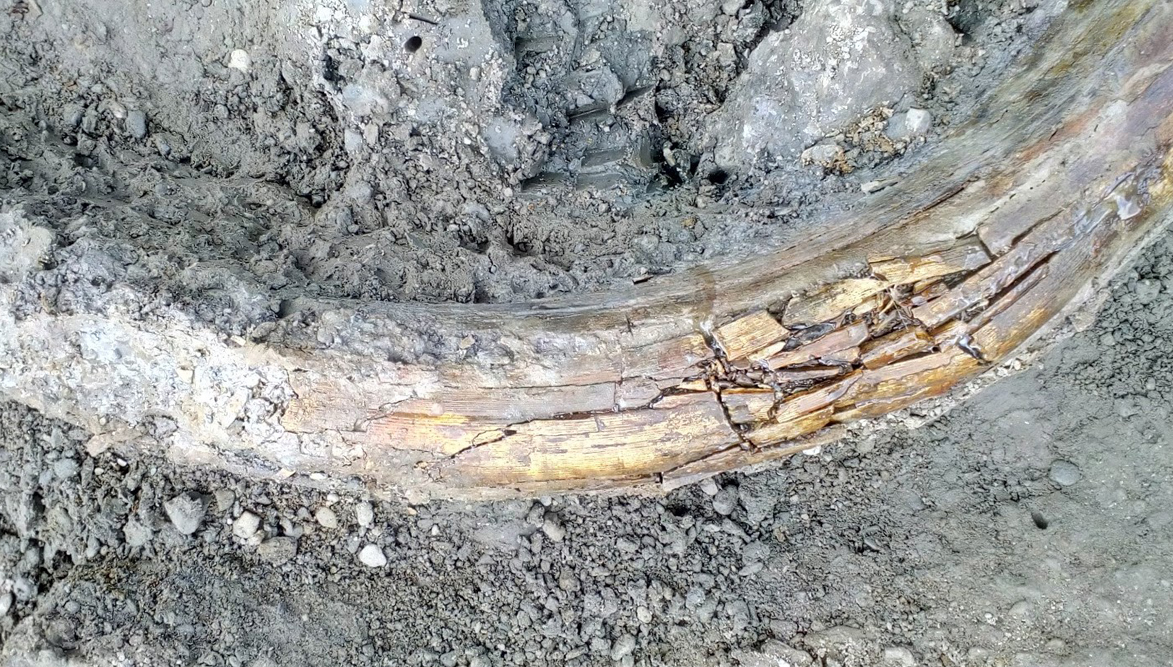
Above left: the mammoth tusk before the excavation commenced. Above right: after cleaning and consolidating the damaged mid-section.
Conservation in the field
The tusk was preserved in situ in the gravel pit in waterlogged conditions, encased within compacted gravels and other sediment. The specimen was carefully exposed around the sides, leaving some sediment in place around the tusk so that the tusk itself did not fall apart without the support of the sediment. Acetone was applied with pipettes to the tusk and sediment to act as solvent drying, evaporating some of the moisture out of the tusk surface and sediment attached to it. This enabled Paraloid B72 in acetone to be applied as a consolidant (between 5 and 15 percent in acetone, weight:volume) as less water occupied the pore spaces and the consolidant was able to penetrate further than it would have achieved otherwise. Paraloid B72 adhesive was also applied to keep some pieces of tusk in place that had been disturbed. Once the consolidant and adhesive had set a rigid field jacket was made to safely lift and transport the specimen in. First, layers of acid-free tissue were wrapped around the tusk as it was excavated, followed by a layer of aluminium foil, held in place with masking tape. Plaster of Paris was then applied to the foil with strips of hessian, and a wooden splint was applied across the curve, held in place with plaster-soaked hessian. This made a robust and rigid field jacket around the specimen so that when the plaster had set it could be lifted, turned upside down (to provide more support to the specimen from underneath) and taken to a waiting vehicle.

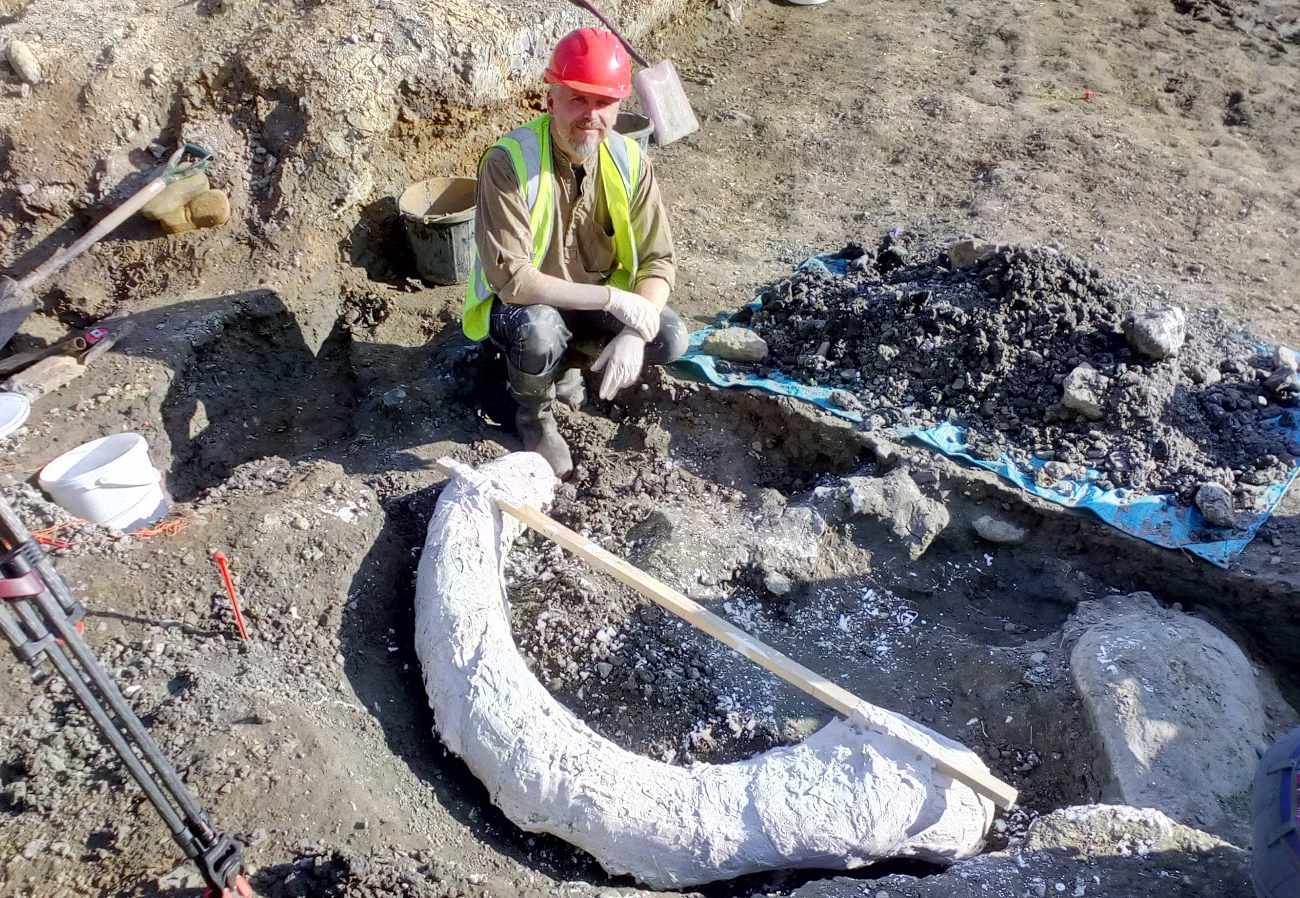
Above left: making the rigid field jacket around the mammoth tusk, to give it as much protection as possible. Above right: the tusk ready for lifting.
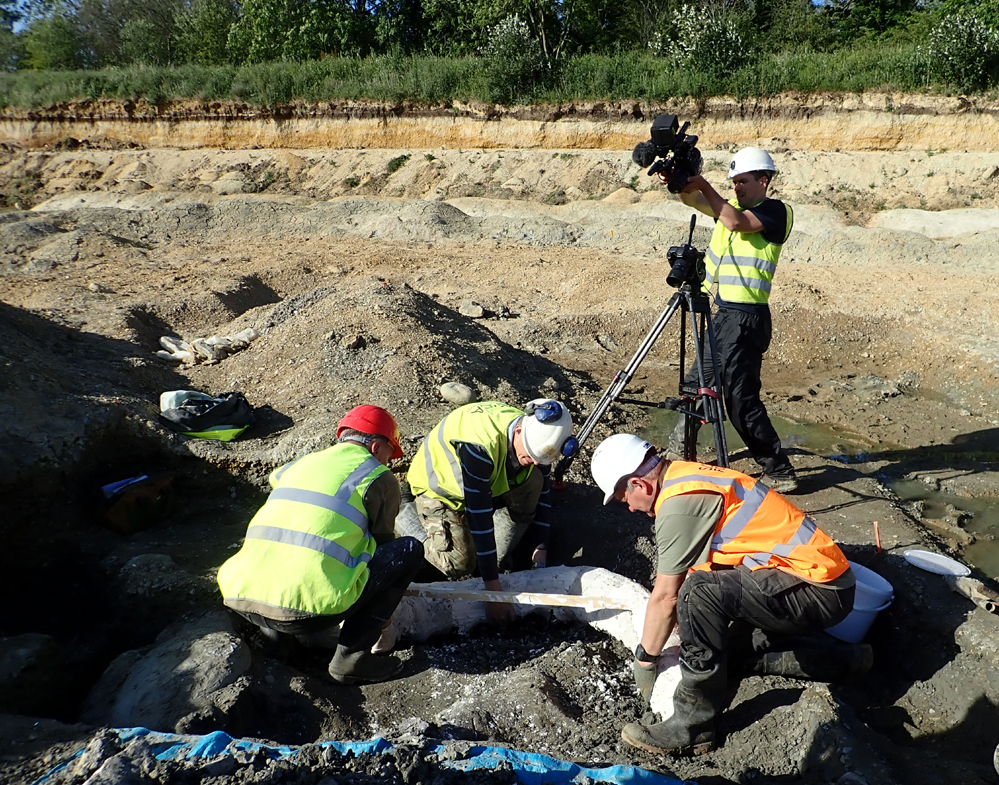
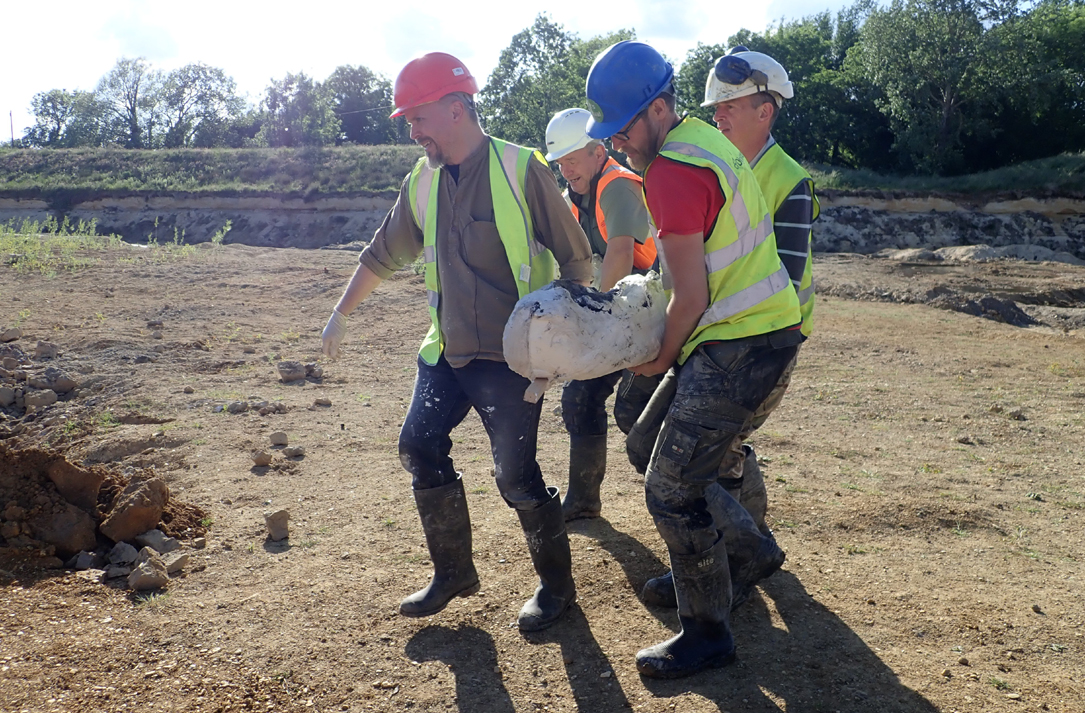
Above: It took four men to lift and carry the tusk to the waiting vehicle. That is me in the red helmet. Note the cameraman filming for the BBC documentary on the site.
Conservation in the lab
For the tusk to be measured, photographed, studied and described fully the field jacket and the sediment surrounding the tusk would need to be carefully removed from the specimen, and the surface of the specimen would be cleaned and consolidated. The specimen had been transported and stored upside-down (compared to its original orientation in the field) on a pallet as the way the plaster of paris field jacket was made offered the most amount of support and protection this way up, which is standard practice. Also, this means that the underside is cleaned and conserved first, before turning the specimen over and working on the top side, so that the topside (as found in the field) is ultimately presented uppermost.

Above: the mammoth tusk in its plaster field jacket before cleaning and conservation.
The plaster field jacket was dampened with water by spraying with a mister, then was covered with plastic and left overnight. This softened the top layer of plaster. Small sections of the plaster jacket at a time were then slowly removed from the top layers of the field jacket using scalpels, keyhole saws, pincers and a DeWalt Multitool (with a small wide saw blade that oscillates at a high frequency). As the plaster, foil and acid-free tissue were removed, sediment was also removed with wooden sculpting tools to reveal the surface of the tusk. Removal of the jacket and sediment would stop once an area about a foot long was revealed along the top and sides of the exposed tusk (the lower half of the tusk was temporarily left in the field jacket, which continued to provide support). The area of tusk free of the field jacket and sediment would then be cleaned. After some dry brushing with small soft artists brushes to remove the remaining sediment (under a dust extract), small amounts of acetone would be applied to the tusk fragments by brush or pipette as required to dissolve any excess consolidant applied in the field or where consolidant had adhered sediment or acid-free tissue to the surface of the tusk. Once the area was cleaned, clean Paraloid B72 consolidant (5% in acetone) would be applied and allowed to soak in. Then consoliant at 10% strength would be applied to cracks between pieces of tusk, followed by a thin line of Paraloid adhesive to ensure the adjoining pieces of tusk were stable. This continued until the whole of the underside of the tusk was clean and free from all sediment and traces of the field jacket and had been consolidated. Most of the sediment removed from the field jacket (about 40 kg) was kept, and is stored in two large lidded buckets in case it is of use for analyses in the future. Fragments of the tusk that were supplied in a bag (as surface finds) were reunited with the tusk where possible.


Above: the underside of the mammoth tusk cleaned of sediment and consolidated but still lying in the upper half of the field jacket.
The cleaned and conserved underside of the tusk (as found in the field; currently uppermost) then required a permanent strong rigid storage jacket to be made, so that the specimen could be turned over and the remaining half of the plaster field jacket removed. White Plastazote foam 10mm thick was cut to the shape of the cleaned surface of the tusk and was scored with a scalpel along its length so that the foam curved round the tusk. Plastazote foam is a chemically inert, low density, closed-cell cross-linked polyethylene foam of archival quality (see: Larkin, N. R. 2010. Literally a ‘mammoth task’: The conservation, preparation and curation of the West Runton Mammoth skeleton. Quaternary International 228, 233-240). Thin polypropylene thread was tied to a curved needle and a running stitch was applied to the top surface of the foam. This is so that the Jesmonite acrylic resin that was applied next would set around the thread as well as adhere to the upper surface of the foam, bonding the foam and resin together. Several layers of Jesmonite acrylic resin and woven glass fibre matting were then applied, to make a strong, rigid, jacket. When set, this jacket was carefully removed from the tusk, placed on a plastic sheet on the floor, and wooden blocks secured to the underside of the jacket with more resin and fibre glass, to ensure that the tusk in its jacket would sit firmly on a flat surface without rocking or flexing.
This storage jacket was then carefully replaced back on the tusk. This jacket was taped securely to the plaster field jacket and the whole tusk in its storage jacket and field jacket was slowly and carefully turned over by two people so that the remaining half of the plaster field jacket was uppermost and the specimen was now the same way up as found in the field. The plaster jacket and sediment were removed using the same methods described above and the same cleaning and conservation methods were applied to the surface of the tusk. The upper surface, however, had been disturbed and damaged in the field. Some pieces of the top surface of the mid-section of the tusk had been misaligned (but adhered in place temporarily during excavation before jacketing) and much of the inside curve of the distal third was missing, as was the tip of the tusk. A few pieces had been disturbed at the proximal end, around the pulp cavity. The pieces in the mid-section were rearranged back into position but significant gaps remained so these were filled with plaster of paris. Photographs were taken as a record of the work, then the plaster was painted with artists’ acrylic paints to closely match the surrounding tusk but not so perfectly that in the future a curator, conservator or researcher could not tell which areas were plaster and which were tusk, as is standard practice. Two pieces of tusk were replaced to their original positions at the proximal end in a similar way. The tusk, in its permanent supportive jacket was placed on a permanent purpose-made pallet made to the required size so that the specimen can be picked up and moved around on the pallet, rather than being picked up in its jacket, minimising the risk of damage to the tusk.

Above: the top side of the tusk (as found in the field) cleaned and conserved, sitting in the permanent storage jacket.
It is clear that the underside of the tusk - which remained buried during the excavations in the quarry – is much better preserved. The top side is damaged. It is unlikely that this damage to the topside presents taphonomic evidence of burial conditions. It is more likely that the damage represents the conditions within the quarry during excavations. Therefore a permanent storage jacket was also made for the uppermost surface so that the tusk can be turned over to present the more complete 'underside'if required.

Above: the fully conserved tusk in its rigid permanent storage jacket, in its original orientation (i.e. as found in the field).
For more details about what we can do for you, or for a quote, please
contact:
enquiries@natural-history-conservation.com
We
are members of the United Kingdom Institute for Conservation of Historic and
Artistic Works
